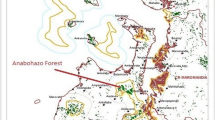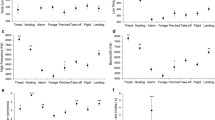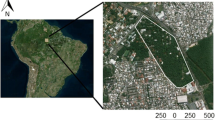Abstract
The study of animal sound signals can be useful in assisting conservation strategies. Understanding the vocal repertoires of endangered species and the behavioral contexts in which they are given is relevant for monitoring protocols, such as those based on automated sound recordings. The pied tamarin (Saguinus bicolor) is at risk of extinction because of deforestation and urban growth in its restricted geographic range. Between 2012 and 2015 we studied the vocal repertoire of the species and the contexts in which different signals are emitted. We made focal recordings of eight free-living groups, two rescued individuals, and one temporarily captive group of pied tamarins in Manaus, central Brazilian Amazonia. From the 766 sounds analyzed we identified 12 distinct signals within the range of 2–11 kHz. Most signals were emitted during resting or locomotion. Less frequently emitted signals were associated with intergroup agonistic interactions, foraging, and infant-exclusive vocalizations. These results increased the known vocal repertoire of the pied tamarin providing more reliable baseline data for monitoring the species by means of automated or focal sound recordings.





Similar content being viewed by others
References
Altmann, J. (1974). Observational study of behavior: Sampling methods. Behaviour, 48(3), 227–267.
Ayres, M. J., Mittermeier, R. A., & Constable, I. D. (1982). Brazilian tamarins on the way to extinction? Oryx, 16(4), 329–333.
Azevedo, R. B. (2006). Ecologia cognitiva e forrageio social em Saguinus bicolor (SPIX, 1823). Master’s thesis, Porto Alegre, Pontifícia Universidade Católica do Rio Grande do Sul.
Benz, J. J., Leger, D. W., & French, J. A. (1992). Relation between food preference and food-elicited vocalizations in golden lion tamarins (Leontopithecus rosalia). Journal of Comparative Psychology, 106(2), 142–149.
Bezerra, B. M., & Souto, A. (2008). Structure and usage of the vocal repertoire of Callithrix jacchus. International Journal of Primatology, 29(3), 671–701.
Blumstein, D. T., Mennill, D. J., Clemins, P., Girod, L., Yao, K., et al (2011). Acoustic monitoring in terrestrial environments using microphone arrays: Applications, technological considerations and prospectus. Journal of Applied Ecology, 48(3), 758–767.
BRASIL. (2014). Ministério do Meio Ambiente. Lista oficial de espécies da fauna ameaçadas de extinção. Portaria 444, 17 de dezembro de 2014. http://www.icmbio.gov.br/portal/images/stories/biodiversidade/fauna-brasileira/avaliacao-do-risco/PORTARIA_N%C2%BA_444_DE_17_DE_DEZEMBRO_DE_2014.pdf. Accessed 20 Oct 2016.
Briefer, E. (2012). Vocal expression of emotions in mammals: Mechanisms of production and evidence. Journal of Zoology, 288(1), 1–20.
Calleia, F. O., Röhe, F., & Gordo, M. (2009). Hunting strategy of the margay (Leopardus wiedii) to attract the wild pied tamarin (Saguinus bicolor). Neotropical Primates, 16(1), 32–34.
Campbell, M. W., & Snowdon, C. T. (2007). Vocal response of captive-reared Saguinus oedipus during mobbing. International Journal of Primatology, 28(2), 257–270.
Caselli, C. B., Mennill, D. J., Gestich, C. C., Setz, E., & Bicca-Marques, J. C. (2015). Playback responses of socially monogamous black-fronted titi monkeys to simulated solitary and paired intruders. American Journal of Primatology, 77(11), 1135–1142.
Cleveland, J., & Snowdon, C. T. (1982). The complex vocal repertoire of the adult cotton-top tamarin (Saguinus oedipus oedipus). Zeitschrift für Tierspsychologie, 58(3), 231–270.
Dacier, A., de Luna, A. G., Fernandez-Duque, E., & Di Fiore, A. (2011). Estimating population density of Amazonian titi monkeys (Callicebus discolor) via playback point counts. Biotropica, 43(2), 135–140.
Egler, S. (1986). Estudos bionomicos de Saguinus bicolor (Spix, 1823)(Callitrichidae: Primates), em mata tropical alterada, Manaus (AM). Master’s thesis: Campinas, Universidade Estadual de Campinas.
Egler, S. G. (1991). Double-toothed kites following tamarins. The Wilson Bulletin, 103(3), 510–512.
Egler, S. G. (1996). Feeding ecology of Saguinus bicolor bicolor (Callitrichidae: Primates) in a relict forest in Manaus, Brazilian Amazonia. Folia Primatologica, 59(2), 61–76.
Elowson, A. M., Tannenbaum, P. L., & Snowdon, C. T. (1991). Food-associated calls correlate with food preferences in cotton-top tamarins. Animal Behaviour, 42(6), 931–937.
Epple, G., Epple, A., & Baker, A. J. (2002). Scent marking patterns of pied tamarins (Saguinus bicolor bicolor, Callitrichinae). Primate Report, 55–61.
Farias, I. P., Santos, W. G., Gordo, M., & Hrbek, T. (2015). Effects of forest fragmentation on genetic diversity of the critically endangered primate, the pied tamarin (Saguinus bicolor): Implications for conservation. Journal of Heredity, 106, 512–521.
Figueira, L., Tella, J. L., Camargo, U. M., & Ferraz, G. (2015). Autonomous sound monitoring shows higher use of Amazon old growth than secondary forest by parrots. Biological Conservation, 184, 27–35.
Fischer, J., & Zinner, D. (2011). Communication and cognition in primate group movement. International Journal of Primatology, 32(6), 1279–1295.
Friant, S. C., Campbell, M. W., & Snowdon, C. T. (2008). Captive-born cotton-top tamarins (Saguinus oedipus) respond similarly to vocalizations of predators and sympatric nonpredators. American Journal of Primatology, 70(7), 707–710.
Garber, P. A., & Porter, L. M. (2014). Navigating in small-scale space: The role of landmarks and resource monitoring in understanding saddleback tamarin travel. American Journal of Primatology, 76(5), 447–459.
Gordo, M. (2012). Ecologia e conservação do sauim-de-coleira, Saguinus bicolor (Primates; Callitrichidae). Ph.D. thesis, Belém, Museu Paraense Emílio Goeldi.
Gordo, M., Rodrigues, L. F., Vidal, M. D., & Spironello, W. R. (2008). Primatas. In M. L. Oliveira, F. B. Baccaro, R. Braga-Neto, & W. E. Magnusson (Eds.), Reserva Ducke: A Biodiversidade amazônica através de uma grade (pp. 39–50). Áttema Design Editorial: Manaus.
Gordo, M., Calleia, F. O., Vasconcelos, S. A., Leite, J. J. F., & Ferrari, S. F. (2013). The challenges of survival in a concrete jungle: Conservation of the pied tamarin (Saguinus bicolor) in the urban landscape of Manaus, Brazil. In L. K. Marsh & C. A. Chapman (Eds.), Primates in fragments (pp. 357–370). Developments in Primatology: Progress and prospects. New York: Springer science+business media.
Halloy, M., & Kleiman, D. G. (1994). Acoustic structure of long calls in free-ranging groups of golden lion tamarins, Leontopithecus rosalia. American Journal of Primatology, 32(4), 303–310.
Hammer, O., Harper, D., & Ryan, P. (2001). PAST: Paleontological statistics software for education and data analysis. Paleontología Electrónica, 4(1), 1–9.
Hershkovitz, P. (1977). Living new world monkeys (Platyrrhini), Vol. 1: With an introduction to primates. Chicago: Chicago University Press.
Kalan, A. K., Piel, A. K., Mundry, R., Wittig, R. M., Boesch, C., & Kühl, H. S. (2016). Passive acoustic monitoring reveals group ranging and territory use: A case study of wild chimpanzees (Pan troglodytes). Frontiers in Zoology, 13(1), 13–34.
Kirchhof, J., & Hammerschmidt, K. (2006). Functionally referential alarm calls in tamarins (Saguinus fuscicollis and Saguinus mystax): Evidence from playback experiments. Ethology, 112(4), 346–354.
Laiolo, P. (2010). The emerging significance of bioacoustics in animal species conservation. Biological Conservation, 143(7), 1635–1645.
Masataka, N. (1982). A field study on vocalizations of Goeldi’s monkeys (Callimico goeldii). Primates, 23(2), 206–219.
McGarigal, K., Cushman, S. S., & Stafford, S. (2000). Multivariate statistics for wildlife and ecology research. New York: Springer Science+Business Media.
Moody, M. I., & Menzel Jr., E. W. (1976). Vocalizations and their behavioral contexts in the tamarin Saguinus fuscicollis. Folia Primatologica, 25(2–3), 73–94.
Morton, E. S. (1977). On the occurrence and significance of motivation-structural rules in some bird and mammal sounds. The American Naturalist, 111(981), 855–869.
Ordóñez-Gómez, J. D., Dunn, J. C., Arroyo-Rodríguez, V., Méndez-Cárdenas, M. G., Márquez-Arias, A., & Santillán-Doherty, A. M. (2015). Role of emitter and severity of aggression influence the agonistic vocalizations of Geoffroy’s spider monkeys (Ateles geoffroyi). International Journal of Primatology, 36(2), 429–440.
Owren, M. J., & Rendall, D. (2001). Sound on the rebound: Bringing form and function back to the forefront in understanding nonhuman primate vocal signaling. Evolutionary Anthropology, 10(2), 58–71.
Peck, M., Thorn, J., Mariscal, A., Baird, A., Tirira, D., & Kniveton, D. (2011). Focusing conservation efforts for the critically endangered brown-headed spider monkey (Ateles fusciceps) using remote sensing, modeling, and playback survey methods. International Journal of Primatology, 32(1), 134–148.
Pijanowski, B. C., Villanueva-Rivera, L. J., Dumyahn, S. L., Farina, A., Krause, B. L., et al (2011). Soundscape ecology: The science of sound in the landscape. Bioscience, 61(3), 203–216.
Price, E. C., Wormell, D., Brayshaw, M., Furrer, S., Heer, T., & Steinmetz, H. W. (2012). Managing free-ranging callitrichids in zoos. International Zoo Yearbook, 46, 123–136.
R Development Core Team (2012). R: A language and environment for statistical computing. Vienna: R Foundation for Statistical Computing http://www.R-project.org.
Richard-Hansen, C., Vié, C. J., & Thoisy, B. T. (2000). Translocation of red howler monkeys (Alouatta seniculus) in French Guiana. Biological Conservation, 93(2), 247–253.
Ringler, M., Ringler, E., Magaña-Mendoza, D., & Hödl, W. (2011). Intrusion experiments to measure territory size: Development of the method, tests through simulations, and application in the frog Allobates femoralis. PloS One, 6, e25844.
Röhe, F. (2006). Área de contato entre as distribuições geográficas de Saguinus midas e Saguinus bicolor (Callitrichidae- Primates): A importância de interações e fatores ecológicos. In Master’s thesis. Manaus: Instituto Nacional de Pesquisas da Amazônia.
Roush, R. S., & Snowdon, C. T. (1994). Ontogeny of food-associated calls in cotton-top tamarins. Animal Behaviour, 47(2), 263–273.
Ruppell, J. C. (2010). Vocal diversity and taxonomy of Nomascus in central Vietnam and southern Laos. International Journal of Primatology, 31(1), 73–94.
Savage, A., Thomas, L., Leighty, K. A., Soto, L. H., & Medina, F. S. (2010). Novel survey method finds dramatic decline of wild cotton-top tamarin population. Nature Communications, 1(3), 1–7.
Schrader, L., & Todt, D. (1993). Contact call parameters covary with social context in common marmosets. Callithrix j. jacchus. Animal Behaviour, 46(5), 1026–1028.
Simões, P. I., Stow, A., Hödl, W., Amézquita, A., Farias, I. P., & Lima, A. P. (2014). The value of including intraspecific measures of biodiversity in environmental impact surveys is highlighted by the Amazonian brilliant-thighed frog (Allobates femoralis). Tropical Conservation Science, 7(4), 811–828.
Snowdon, C. T. (1993). A vocal taxonomy of the callitrichids. In A. B. Rylands (Ed.), Marmosets and tamarins: Systematics, behaviour, and ecology (pp. 78–94). New York: Oxford University Press.
Sobroza, T. V. (2015). Ecologia comportamental de Saguinus midas e Saguinus bicolor (Primates: Callitrichidae) em áreas de contato entre distribuições geográficas. In Master’s thesis. Manaus: Instituto Nacional de Pesquisas da Amazônia.
Spillmann, B., Noordwijk, M. A. V., Willems, E., Setia, T. M., Wipfli, U., & van Schaik, C. P. (2015). Validation of an acoustic location system to monitor Bornean orangutan (Pongo pygmaeus wurmbii) long calls. American Journal of Primatology, 77(7), 767–776.
Subirá, R. (1998). Avaliação da Situação atual das Populações selvagens do Sauim-de-coleira Saguinus b.bicolor (Spix, 1823). Master’s thesis. Brasília: Universidade de Brasília.
Sueur, J., Pavoine, S., Hamerlynck, O., & Duvail, S. (2008a). Rapid acoustic survey for biodiversity appraisal. PloS One, 3(12), e4065.
Sueur, J., Aubin, T., & Simonis, C. (2008b). Equipment review: Seewave, a free modular tool for sound analysis and synthesis. Bioacoustics, 18(2), 213–226.
Thinh, V. N., Hallam, C., Roos, C., & Hammerschmidt, K. (2011). Concordance between vocal and genetic diversity in crested gibbons. BMC Evolutionary Biology, 11(1), 11–36.
Thompson, M. E., Schwager, S. J., Payne, K. B., & Turkalo, A. K. (2010). Acoustic estimation of wildlife abundance: Methodology for vocal mammals in forested habitats. African Journal of Ecology, 48(3), 654–661.
Wadewitz, P., Hammerschmidt, K., Battaglia, D., Witt, A., Wolf, F., & Fischer, J. (2015). Characterizing vocal repertoires hard vs. soft classification approaches. PLoS ONE, 10(4), e0125785.
Waser, P. M. (1977). Individual recognition, intragroup cohesion and intergroup spacing: Evidence from sound playback to forest monkeys. Behaviour, 60(1), 28–74.
Wich, S. A., & Nunn, C. L. (2002). Do male “long-distance calls” function in mate defense? A comparative study of long-distance calls in primates. Behavioral Ecology and Sociobiology, 52(6), 474–484.
Acknowledgments
We are grateful to Secretaria Municipal de Meio Ambiente e Sustentabilidade de Manaus, Instituto Nacional de Pesquisas da Amazônia and local farmers for granting us access to the study sites. We thank Mônica Solório, Thierry Gasnier and the Pied Tamarin Project staff for aid during study planning and reviewing earlier drafts of this manuscript. We also thank the two anonymous reviewers, and the editor-in-chief, Joanna Setchell for their helpful suggestions and comments on previous versions of the manuscript. Adrian Barnett helped with the English. In the time span of this study T. V. Sobroza received scholarships provided by ANDIFES/Santander Bank partnership, Programa de Educação Tutorial (MEC\Sesu) and CNPq (process number: 131119\2013-3). P. I. Simões received a postdoctoral fellowship from PNPD-CAPES through Programa de Pós-Graduação em Zoologia of PUCRS. Part of the study was supported by the Primate Action Fund (PAF 14-15; CI Contract 1000796). This is publication number 21 from the Amazon Mammal Research Group, INPA.
Author information
Authors and Affiliations
Corresponding author
Additional information
Handling Editor: Joanna M. Setchell
Rights and permissions
About this article
Cite this article
Sobroza, T.V., Cerqueda, L.S., Simões, P.I. et al. Vocal Repertoire and Its Behavioral Contexts in the Pied Tamarin, Saguinus bicolor . Int J Primatol 38, 642–655 (2017). https://doi.org/10.1007/s10764-017-9971-z
Received:
Accepted:
Published:
Issue Date:
DOI: https://doi.org/10.1007/s10764-017-9971-z




